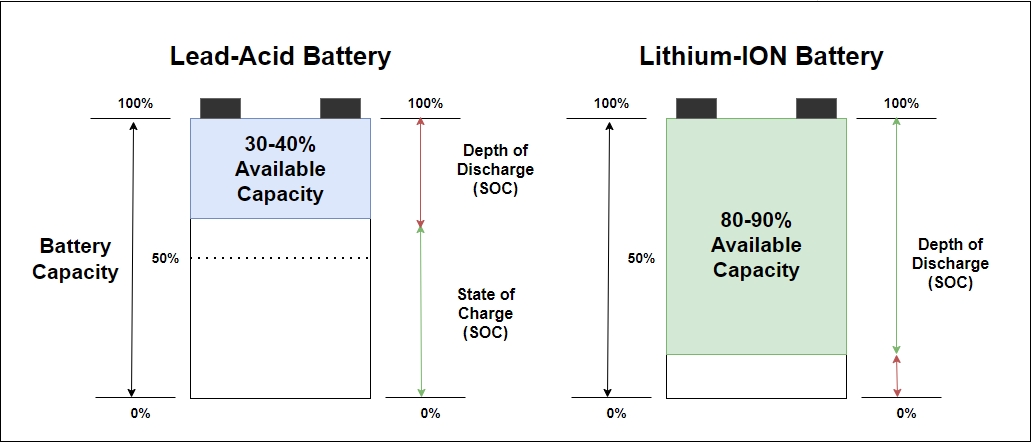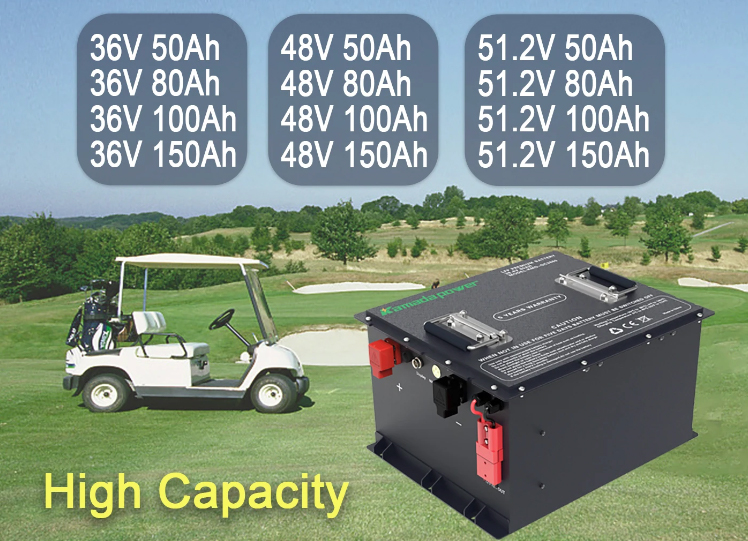How Much Does It Cost To Replace The Batteries In A Golf Cart? Golf carts aren’t just a staple on the links anymore. These days, you’ll find them zipping around residential areas, luxury resorts, and business venues alike. Now, here’s something to chew on: those golf cart lithium-ion batteries? They don’t last forever. Just like your trusty smartphone or laptop, they’ve got a shelf life. Sooner or later, you’ll be in the market for a battery swap. Stick with us in this blog, and we’ll break down what it’ll cost you to revamp those golf cart batteries and offer some solid advice to guide your decision-making.

Factors Influencing the Cost of Golf Cart Batteries
Golf Cart Batteries Type
When it comes to golf cart batteries, you’ve got options. You can go old-school with the tried-and-true lead-acid batteries or opt for the newer, high-tech lithium-ion ones. Lead-acid batteries might be easier on your wallet, but if you’re looking for longevity and top-notch performance, lithium-ion batteries are where it’s at—though they do come with a heftier price tag.

| Key Factors | Golf Cart Lead-Acid Battery | Golf Cart Lithium-Ion Battery |
|---|---|---|
| Cost | Affordable | Higher upfront |
| Lifespan (Charge Cycles) | 500~1000 cycles | 3000~5000 cycles |
| Performance | Standard | High |
| Weight | Heavier | Lighter |
| Maintenance | Regular | Minimal |
| Charging Time | Longer | Shorter |
| Efficiency | Lower | Higher |
| Environmental Impact | More pollutants | Eco-friendly |
For years, lead acid batteries have been the go-to option for golf carts due to their affordability and widespread availability. However, they come with their set of challenges. They’re heavier, demand frequent maintenance like water level checks and terminal cleaning, and generally have a shorter lifespan compared to their lithium counterparts. Over time, lead acid batteries can lose their capacity and might not deliver consistent power.
On the flip side, lithium iron phosphate (LiFePO4) batteries present several compelling advantages. They’re lightweight, boast a longer life cycle, and need minimal upkeep. These batteries deliver consistent power throughout their discharge cycle and can operate efficiently even when discharged to a lower state. Plus, LiFePO4 batteries offer a higher energy density, enabling them to pack more power in a compact design, leading to enhanced range and performance.
While LiFePO4 batteries might come with a steeper initial price tag compared to lead acid ones, their extended lifespan and superior performance can translate to long-term savings.
Making the Right Choice for Your Golf Cart Batteries
In the end, the choice between lead acid and lithium iron phosphate batteries hinges on your unique requirements and budget constraints. If you’re cost-conscious and don’t mind regular upkeep, lead acid batteries could suffice. However, if you’re after a lightweight, longer-lasting, and high-performing option, LiFePO4 batteries emerge as the frontrunner. To make an informed decision tailored to your needs, it’s always wise to seek advice from a trusted battery supplier or golf cart specialist.
Golf Cart Batteries Voltage and Capacity
When you’re picking out a golf cart battery, think of voltage as your power gauge. You’ve got everything from 6V 8V 12V 24V 36V 48V, and some even go higher for that extra kick on the course. Now, let’s talk juice – that’s where battery capacity comes in, measured in ampere-hours (Ah). More Ah means you’re spending less time charging and more time cruising the greens. Sure, the higher voltage and bigger Ah might hit your wallet a bit harder upfront, but they’ll give you better performance and last longer in the long run. So, for all you golf enthusiasts out there, it’s a smart move to invest in the good stuff.
Number of Golf Cart Batteries
In the world of golf carts, it’s common to see a series of batteries linked together to meet the required voltage. The price tag can climb based on how many batteries your particular cart model demands.
Golf Cart Battery Replacement Average Cost Range
Navigating the market for golf cart batteries? The cost range for battery replacements can fluctuate based on a variety of factors. These include the brand reputation, the expertise of the retailer, geographic location, and specific battery features. Generally speaking, investing in a new set of golf cart batteries could set you back anywhere from around $500 to approximately $3000. It’s essential to consider quality, longevity, and performance when making this crucial purchase for your golf cart’s optimal functioning and efficiency.
| Type of Battery | Average Cost Range ($) | Advantages | Disadvantages |
|---|---|---|---|
| Lead-Acid | 500 – 800 | - Affordable - Widely available |
- Shorter lifespan |
| Lithium-Ion | 1000 – 3000 | - Longer lifespan - Superior performance |
- Higher initial cost |
Is It Better to Replace All Golf Cart Batteries Simultaneously?
When it comes to golf cart batteries, the general consensus leans towards replacing them all at once. Let’s delve into the reasons behind this recommendation:
Uniformity
Golf cart batteries function as a cohesive unit, supplying power uniformly to the cart. Mixing new batteries with older ones can introduce inconsistencies in capacity, age, or performance, leading to uneven power delivery and compromised performance.
Battery Longevity
Most golf cart batteries share a similar lifespan. Introducing significantly older or deteriorated batteries to a mix can adversely impact the performance and lifespan of the newer ones. Swapping out all batteries simultaneously ensures uniform longevity, optimizing their overall lifespan.
Streamlined Maintenance
Opting for a partial battery replacement means juggling maintenance and troubleshooting schedules for different batteries. A complete battery overhaul simplifies maintenance, minimizing potential issues stemming from mismatched batteries.
Cost-Effectiveness
While a full battery replacement may come with a higher initial investment, it often proves more economical in the grand scheme. A harmonized battery system reduces the risk of premature battery failures and curtails the frequency of replacements, offering long-term savings.
Consult Manufacturer Guidelines for Optimal Battery Replacement
Always refer to your golf cart manufacturer’s guidelines and recommendations. They might offer specific insights or directives concerning battery replacement tailored to your golf cart model, ensuring optimal performance and longevity.
Unlock Peak Performance with Kamada’s 36V 105AH LiFePO4 Golf Cart Battery
In search of a battery that’s as passionate about golf as you are? Meet the Kamada 36V 105AH LiFePO4 Golf Cart Battery – the game-changer you’ve been waiting for. Crafted with state-of-the-art technology and tailored features, this lithium powerhouse is poised to redefine your golfing escapades.
Searching for a durable, high-performance battery for your golf cart?
Meet the Kamada 36V 105AH LiFePO4 Golf Cart Battery. Engineered with advanced tech and integrated features, this rechargeable lithium battery is poised to transform your golfing adventures.

Big Power
With a max power of 2891.7kW, the Kamada 36V 105AH LiFePO4 Golf Cart Battery amps up your game on the green. Feel the boost in speed, acceleration, and overall handling, making your time on the course a breeze.
To calculate the maximum power output (kW) of a battery, the following formula is typically used:
Maximum Power (kW)=Battery Voltage (V) × Battery Capacity (Ah) × Efficiency Factor
In this case, we have:
Battery Voltage (V) = 36V
Battery Capacity (Ah) = 105AH
To obtain an accurate maximum power value, we also need an efficiency factor. Typically, for Lithium Iron Phosphate (LiFePO4) batteries, the efficiency factor ranges between 0.8 to 0.9. Here, we will use 0.85 as the efficiency factor.
Substituting these values into the formula:
Maximum Power (kW)=36V × 105Ah × 0.85
Maximum Power (kW)=36×105×0.85
Maximum Power (kW)=3402×0.85
Maximum Power (kW)=2891.7kW
Super Durable
Engineered to tackle the demands of golf cart adventures, the Kamada battery flaunts an astounding lifespan exceeding 4000 cycles. Bid farewell to frequent battery swaps and gear up for years of uninterrupted play. Whether you’re a weekend warrior or a frequent fairway navigator, this battery has got your back.
Safety Meets Smarts
Housing a sophisticated 105A Battery Management System (BMS), Kamada ensures your battery’s safety. Guarding against overcharging, over-discharging, and potential short circuits, the BMS offers peace of mind, allowing you to stay focused on your swing, not your battery.
Light weight and rechargeable
Lightweight compared to its lead-acid counterparts, the Kamada LiFePO4 Battery trims down your cart’s weight, enhancing agility and conserving energy. Plus, its rechargeable nature promises hassle-free charging sessions, making power management a breeze.
Enjoy a new level of golf cart fun with the Kamada Power Golf Cart Battery!
Elevate your golfing journey with the Kamada 36V 105AH LiFePO4 Golf Cart Battery. Boasting formidable power, unmatched endurance, cutting-edge safety mechanisms, and a feather-light design, it’s the ultimate companion for golf aficionados craving peak performance and enduring energy. Choose Kamada Battery, and tee off with confidence – no battery anxieties, just pure golfing joy.
When Should You Replace Your Golf Cart Batteries?
Golf carts have become a staple not only on the golf course but also in gated communities and other locales due to their eco-friendly and cost-effective nature, especially for retirees.
Fault Signal Checklist: Is It Time to Replace Your Golf Cart Battery?
| Signs for Golf Cart Battery Replacement | Description/Action | Example |
|---|---|---|
| Struggling on Inclines | - Sluggish performance on small hills – Needing to floor the accelerator – Reduced speed on descents |
When attempting to climb a 15-degree incline, the cart slows down to 3 mph. |
| Extended Charging Times | Longer than usual charging times indicate battery wear and tear. | The battery takes over 15 hours to fully charge but still isn’t fully charged. |
| Delayed Response | - Acceleration delay after pressing the pedal – Reduced braking efficiency |
After pressing the pedal, there’s a 2-second delay before the cart accelerates. |
| Accessory Malfunctions | Accessories powered by the battery (e.g., radio, refrigerator) show hesitation or failure. | Attempting to turn on the cart’s refrigerator results in it not starting. |
| Mid-game Power Drain | Stalling halfway through an 18-hole game indicates a battery issue. | The cart loses power after completing the 12th hole and needs to be towed. |
| Physical Signs of Wear | - Bulging – Leakage Any physical irregularities suggest internal issues. |
Upon inspection, the battery has leaked fluid and shows slight bulging. |
Wondering when it’s time for a battery refresh? Let’s dive into some key signs:
Struggling on Inclines
If your cart struggles with inclines that it used to handle with ease, it’s a clear indicator it’s time for a battery swap. Look out for:
- Sluggish performance on small hills
- Needing to floor the accelerator
- Experiencing reduced speed on descents
Invest in a set of Trojan golf cart batteries to ensure consistent performance and power.
Extended Charging Times
While a typical golf cart battery may need an overnight charge, extended charging times signal wear and tear. Over time, battery efficiency decreases, leading to longer charge durations. If you notice this, it’s a sign that the battery’s effectiveness is waning and replacement is imminent.
Delayed Response
Modern golf carts are equipped with advanced battery tech, ensuring prompt responses to your commands. If you face:
- Delayed acceleration after pressing the pedal
- Reduced braking efficiency
It might be time for new Trojan golf cart batteries. Prompt action can prevent further deterioration and potential hazards.
Accessory Malfunctions
A simple way to gauge battery health is by testing onboard accessories like:
- CD players
- Radios
- Refrigerators
- Air conditioners
Any hesitation or failure indicates a potential battery issue. As the battery weakens, it may struggle to power these accessories. Ensure all components operate as intended.
Mid-game Power Drain
A reliable golf cart should easily last through an 18-hole game. If it stalls halfway, the battery is likely the culprit. New batteries may need initial charging, but they should function without hitches once juiced up.
Physical Signs of Wear
Inspect the battery for:
- Bulging
- Leakage
A well-maintained battery should have a consistent, rectangular shape. Any physical irregularities suggest internal issues, compromising its ability to hold charge and posing potential safety risks. Properly dispose of compromised batteries and clean any leaked substances for optimal safety.
Keep your golf cart running smoothly with timely battery replacements. It ensures not only performance but also safety on the greens.
Post time: Mar-22-2024

